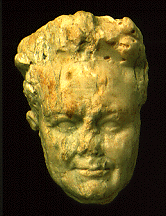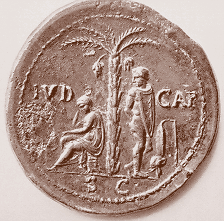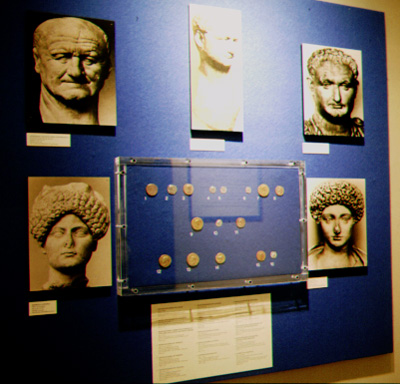
The Flavian period was a time of successful wars, great building projects, and catastrophic events. The eruption of Mount Vesuvius in AD 79 buried Pompeii and other towns along the shores of the Bay of Naples. The famous Colosseum was begun by Vespasian and dedicated by his son Titus in AD 80. The Flavian triumph in the Judaic war and the destruction of the Temple of Jerusalem in AD 70 was later commemorated by one of the most famous monuments of Roman art, the Arch of Titus in the Roman Forum. The Templum Gentis Flaviae was the greatest dynastic monument erected by Domitian, who was, ironically, the last Flavian emperor.
 |
|
Relief
portrait of Vespasian (Kelsey Museum 2430)
|
When Titus Flavius Vespasianus became emperor in AD 69, he ended a year of civil war and restored peace and stability to the Roman Empire. Vespasian could base his claim to the throne on neither aristocratic ancestry nor family ties to the Julio-Claudian dynasty. Yet he possessed two crucial assets. His recent suppression of rebellion in Judaea had capped a distinguised career as a Roman general. Even more importantly, Vespasian was the father of two healthy adult sons, Titus and Domitian, who offered the welcome prospect of establishing a new imperial dynasty. When Vespasian declared that "his sons would succeed him or no one" (Suetonius, Vesp. 25), the Senate and the Roman people acclaimed the founding of the Flavian dynasty.
Vespasian vigorously pursued a propagandistic program of glorifying the Flavian dynasty throughout his 10-year reign. In his first year as emperor, he began a dynastic "public relations campaign" with a magnificent triumph celebrating the Flavian victory over Judaea. Vespasian introduced Titus, the heir apparent, to the populace of Rome as his co-triumphator and the conqueror of Jerusalem. Treasures looted from the Temple in Jerusalem, which had been destroyed by legions under the command of Titus, were featured in the triumphal procession.
Vespasian also inaugurated an ambitious public building program in the name of the Flavian dynasty. It produced one of Rome's most enduring monuments, the Colosseum, which was known to the Romans as the "Flavian Amphitheater" (Amphiteatrum Flavium).
 |
 |
|
Sestertius
of Titus |
Reverse:
Judaea Capta. |
Domitian's emphasis on the divine aspect of his Flavian heritage, however, reflected a dangerous shift in his attitude toward the office of princeps. Domitian made a fatal mistake by abandoning the carefully calibrated Augustan titles of "first citizen" and "first among equals" in favor of the autocratic epithet "lord and god" (dominus et deus). Like Julius Caesar, Domitian miscalculated Roman tolerance for a form of rule that was perceived as too close to cosmic kingship.
Senatorial hostility to Domitian culminated in his assassination in AD 96 but continued after his death. The Senate refused to grant Domitian divine honors and declared a damnatio memoriae against him. This meant that, although Domitian's ashes were surreptitiously interred in the Templum Gentis Flaviae by his childhood nurse, he could never join the other deified Flavians in the official Roman pantheon. It also meant that the image and name of Domitian would be systematically expunged from the many dynastic monuments he had raised throughout Rome.
Despite 27 years of assiduous Flavian propaganda, the Flavian dynasty did not survive the downfall of Domitian.
 |
|
Coins and
portraits of members of the Flavian dynasty.
|
Copyright ©1997, 2002 Ministero per i Beni Culturali e Ambientali, Soprintendenza Archeologica di Roma and the Kelsey Museum of Archaeology, University of Michigan. All rights reserved.